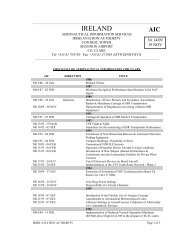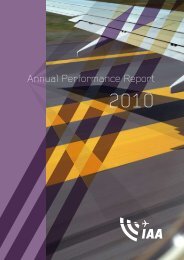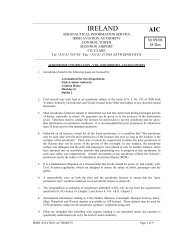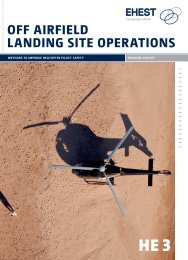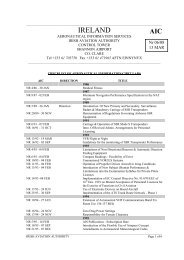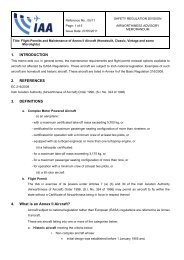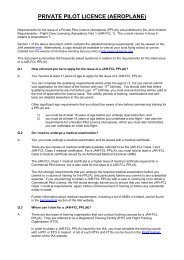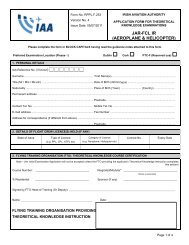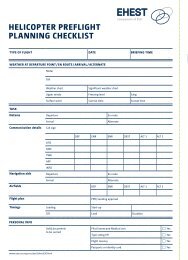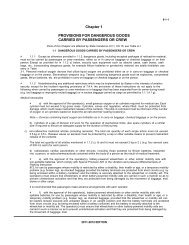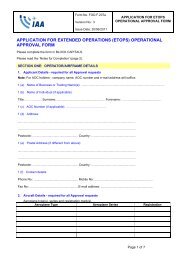AWSD 1/07 EASA Part M - Irish Aviation Authority
AWSD 1/07 EASA Part M - Irish Aviation Authority
AWSD 1/07 EASA Part M - Irish Aviation Authority
You also want an ePaper? Increase the reach of your titles
YUMPU automatically turns print PDFs into web optimized ePapers that Google loves.
Information Letter: <strong>AWSD</strong> 1/<strong>07</strong><br />
<strong>EASA</strong> <strong>Part</strong> M (Subpart G and Subpart F)<br />
Introduction<br />
This information is relevant to General <strong>Aviation</strong> aircraft not used for commercial Air<br />
Transport and is of particular interest to aircraft owners/operators, licensed engineers and<br />
organisations seeking approval under <strong>EASA</strong> <strong>Part</strong> M Subpart G (Airworthiness Management<br />
Organisation) and Subpart F (Maintenance Organisation).<br />
The European <strong>Aviation</strong> Safety Agency (<strong>EASA</strong>) is the agency of the European Union for<br />
aviation safety. The agency became operational in 2003 pursuant to European Parliament and<br />
Council Regulation 1592/2002 referred to as the Basic Regulation. The implementing rule for<br />
Continued Airworthiness, EC 2042/2003 contains detailed requirements for the continued<br />
airworthiness of aircraft including maintenance of all non commercial aircraft under 5700kg.<br />
Aircraft listed in Annex 2 of the Basic Regulation are excluded from these requirements and<br />
national regulations apply instead.<br />
When EC 2042 comes into force for non commercial aviation, multi-engine helicopters will<br />
be classified as large aircraft and will have to be managed by a <strong>Part</strong> M Subpart G<br />
Airworthiness Management organisation and maintained by a <strong>Part</strong> 145 maintenance<br />
organisation.<br />
General <strong>Aviation</strong> (GA) as defined in this leaflet means Small Aircraft not used for<br />
Commercial operations.<br />
How will the new regulations affect you as the Owner/Operator of a General <strong>Aviation</strong><br />
aircraft?<br />
Aircraft will be issued with an <strong>EASA</strong> non expiring Certificate of Airworthiness which will be<br />
validated by an Airworthiness Review Certificate (ARC). The ARC will be valid for one year<br />
and may be extended twice for a one year period before it must be reissued.<br />
To ensure the continued airworthiness of an aircraft an airworthiness review must be carried<br />
out periodically. This airworthiness review includes a review of technical documentation and<br />
the physical survey of the aircraft.<br />
When an aircraft is continuously managed and maintained by an organisation approved in<br />
accordance with <strong>Part</strong> M Subpart G, this activity is carried out by a Subpart G organisation<br />
without the intervention of the IAA.<br />
When an aircraft is not managed by the same organisation the ARC is issued by the IAA<br />
based on a recommendation from an approved Subpart G organisation.<br />
ARCs are currently issued by the IAA under national rules; this will continue until September<br />
2008 when the requirements of EC2042/2003 will apply to General <strong>Aviation</strong> and ARCs may<br />
be issued and extended by <strong>Part</strong> M Subpart G Continuing Airworthiness Management<br />
Organisations (CAMO).<br />
1
Highlights of <strong>Part</strong> M EC2042/2003 as they apply to General <strong>Aviation</strong> are set out below. A<br />
copy of the full regulation is accessible on the <strong>EASA</strong> website<br />
<strong>Part</strong> M paragraph M.A.201 states in summary that the owner is responsible for<br />
ensuring that:<br />
• The aircraft is maintained in an airworthy condition<br />
• Any operational and emergency equipment fitted is correctly installed and serviceable<br />
• The airworthiness certificate remains valid<br />
• The maintenance of the aircraft is performed in accordance with the approved<br />
maintenance programme<br />
Paragraph M.A. 201 allows the owner to contract:<br />
• The tasks associated with the continuing airworthiness to an approved Continuing<br />
Airworthiness Management Organisation (CAMO). In this case, the CAMO assumes<br />
responsibilities for the proper accomplishment of these tasks.<br />
• The maintenance to an approved maintenance organisation.<br />
Paragraph M.A. 304 Approval of Modifications and Repairs:<br />
• Modifications and repairs must be approved according to <strong>Part</strong>-21.<br />
• <strong>EASA</strong> will work on publishing standard practise manuals that will alleviate this<br />
requirement for the simple cases. These documents will initially be based on FAA<br />
Advisory Circular AC 43. 13.<br />
Paragraph M.A. 305 Aircraft Continuing Airworthiness Records:<br />
For General <strong>Aviation</strong> the existing system of log books may be used to satisfy the<br />
requirements of this paragraph.<br />
Subpart G Continuing Airworthiness Management Organisation (CAMO):<br />
An approved CAMO may manage the continuing airworthiness of non-commercial air<br />
transport aircraft as listed on the approval certificate. The CAMO may be authorised to<br />
approve the maintenance programme itself. The CAMO may be approved to issue and extend<br />
the validity of the Airworthiness Review Certificate M.A. 901 Subpart I refers.<br />
Subpart F Maintenance Organisation<br />
This Subpart establishes the requirements to be met by an organisation to qualify for the issue<br />
or continuation of an approval for the maintenance of aircraft and components not listed in<br />
M.A.201(f) and (g).<br />
M.A.602 Application<br />
An application for issue or variation of a maintenance organisation approval shall be made on<br />
a form and in a manner established by the <strong>Irish</strong> aviation <strong>Authority</strong>.<br />
M.A.603 Extent of Approval<br />
The grant of approval is indicated by the issue of a certificate by the <strong>Irish</strong> <strong>Aviation</strong> <strong>Authority</strong>.<br />
The M.A.604 approved maintenance organisation's manual must specify the scope of work.<br />
2
A maintenance organisation may maintain any aircraft and or component which it is approved<br />
at the locations specified in the approval certificate.<br />
Maintenance on components must be performed by Subpart F or <strong>Part</strong> 145 organisations.<br />
However, certifying staff qualified in accordance with M.A.801 (b) (2) may perform<br />
maintenance on components while they are installed on the aircraft<br />
Paragraph M.A. 801Certificate of Release to Service (CRS):<br />
A Certificate of Release to Service shall be issued before flight at the completion of any<br />
maintenance by;<br />
• A <strong>Part</strong> 145 organisation.<br />
• A Subpart F organisation.<br />
• A <strong>Part</strong>-66 licensed engineer for non-complex tasks (see <strong>Part</strong> M Appendix V11)<br />
excluding components off the aircraft.<br />
• An authorised person in the case of Gliders and Balloons.<br />
• A pilot owner MA 803 (see part M Appendix V111)<br />
A pilot-owner is the person who owns or jointly owns the aircraft being maintained and holds<br />
a valid pilot license with the appropriate type or class rating.<br />
For any privately operated aircraft of simple design with a maximum take-off mass of less<br />
than 2730 Kg, glider and balloon, the pilot-owner may issue the Certificate of Release to<br />
Service after the limited pilot owner maintenance listed in Appendix VIII to <strong>Part</strong>-M.<br />
A Certificate of Release to Service issued by a pilot-owner should contain the following<br />
statement:<br />
Certifies that the limited pilot-owner maintenance except as otherwise specified was carried<br />
out in accordance with <strong>Part</strong>-M and in respect to that work the aircraft is considered ready for<br />
release to service<br />
Tasks included in the AFM/Operators Handbook are not considered “Maintenance tasks”<br />
except in those cases where there is an attachment to the AFM showing the maintenance<br />
schedule.<br />
Aircraft not affected by the <strong>EASA</strong> Regulations<br />
Aircraft in the categories listed in Annex 2 to the Basic Regulation 1592/2002 are not<br />
affected by the <strong>EASA</strong> regulations and remain the subject of national regulations. The<br />
existing IAA arrangements will remain in place for the aircraft in the categories below:<br />
• Historic aircraft which are non complex aircraft whose: initial design was established<br />
before 1.1.1955 and production has been stopped before 1.1.1975.<br />
• Aircraft having a clear historical relevance, related to a participation in a noteworthy<br />
historical event; or a major step in the development of aviation; or a major role played<br />
into the armed forces of a Member State.<br />
• Aircraft specifically designed or modified for research, experimental or scientific<br />
purposes, and likely to be produced in very limited numbers;<br />
• Aircraft of which at least 51 % is built by an amateur, or a non-profit making<br />
association of amateurs, for their own purposes and without any commercial<br />
objective;<br />
• aircraft that have been in the service of military forces, unless the aircraft is of a type<br />
for which a design standard has been adopted by the Agency;<br />
3
• aeroplanes, helicopters and powered parachutes having no more than two seats, a<br />
maximum take-off mass (MTOM), as recorded by the Member States, of no more<br />
than:<br />
• 300 kg for a land plane/helicopter, single-seater; or<br />
• 450 kg for a land plane/helicopter, two-seater; or<br />
• 330 kg for an amphibian or floatplane/helicopter single-seater; or<br />
• 495 kg for an amphibian or floatplane/helicopter two-seater, provided that, where<br />
operating both as a floatplane/helicopter and as a land plane/helicopter, it falls below<br />
both MTOM limits, as appropriate;<br />
• 472.5 kg for a land plane, two-seater equipped with an airframe mounted total<br />
recovery parachute system;<br />
• 315 kg for a land plane single-seater equipped with an airframe mounted total<br />
recovery parachute system;<br />
• And, for aeroplanes, having the stall speed or the minimum steady flight speed in<br />
landing configuration not exceeding 35 knots calibrated air speed (CAS);<br />
• Single and two-seater gyroplanes with a maximum take off mass not exceeding 560<br />
kg;<br />
• Gliders with a maximum empty mass, of no more than 80kg when single-seater or<br />
100kg when two-seater, including those which are foot launched;<br />
• Replicas of aircraft meeting the criteria of (a) or (d) above, for which the structural<br />
design is similar to the original aircraft;<br />
• unmanned aircraft with an operating mass of no more less than 150 kg;<br />
• Any other aircraft which has a maximum empty mass, including fuel, of no more less<br />
than 70 kg.<br />
Any queries can be e-mailed to jim.corbett@iaa.ie<br />
Information regarding the agency and the Regulations may be found on <strong>EASA</strong> web site<br />
www.easa.eu.int<br />
4




